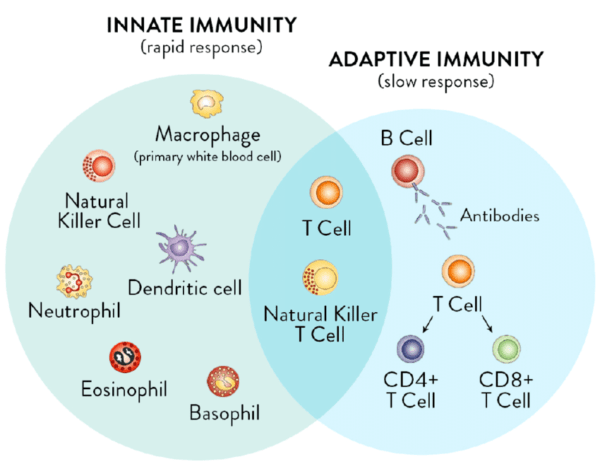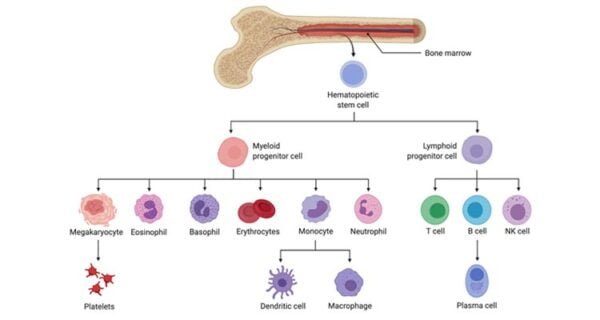The immune system is an incredibly complex network of cells, tissues, and organs designed to defend the body against harmful pathogens and maintain overall health. Its major components include lymph nodes, mucosa-associated lymphoid tissues (MALT), and skin-associated lymphoid tissues (CALT), each of which plays a vital role in immune surveillance and response. Lymph nodes act as filtration points where lymphocytes interact with foreign antigens, while MALT and CALT act as the body’s first line of defense, monitoring mucosal surfaces and the skin to detect potential threats. This guide delves into these components, their functions, and their roles in both innate and adaptive immunity to provide a thorough understanding of how the body mounts an effective defense against infection and disease.
1. Lymph nodes
1.1. Overview of lymph nodes
Lymph nodes are an important component of the lymphatic system, acting as filtering points for lymphatic fluid and as centers of immune response. Lymph nodes are scattered throughout the body and play a vital role in the body’s defense against pathogens.
- Functions of lymph nodesLymph nodes filter lymph, the fluid that circulates through the lymphatic system, trapping foreign particles and pathogens, and are sites of lymphocyte activation and proliferation.
1.2. Lymphocyte and antigen entry
- Afferent lymphatic vesselsLymphocytes and foreign antigens enter lymph nodes through afferent lymphatic vessels. This entry allows for surveillance and initiation of immune responses within the lymph node.
1.3. Distribution of lymphocytes in lymph nodes
- B lymphocytesThese cells reside primarily in follicles within the cortex of the lymph node. The cortex is the outer layer of the lymph node and contains organized areas called follicles, where B cells encounter antigens. Upon activation, B cells differentiate into plasma cells that produce antibodies specific to the antigen.
- T lymphocytesT cells reside primarily in the juxtamembrane (JPC), the region between the cortex and medulla, which is crucial for T cell activation, where they interact with antigen-presenting cells and become activated to carry out immune functions.
2. MALT and CALT
2.1. Mucosa-associated lymphoid tissue (MALT)
MALT are important components of the immune system that are located at mucosal surfaces, which are the main points of entry for pathogens and antigens.
- Location and FeaturesMALT are present in the mucosal regions of the gastrointestinal, respiratory, and genitourinary tracts and act as a first line of defense against pathogens that enter the body through these sites.
- Components of MALTMALT are rich in macrophages and lymphocytes that are essential for antigen detection and response. Examples of MALT include:
- tonsilLocated in the throat and mouth, it is one of the first sites to encounter ingested or inhaled pathogens.
- appendixThe appendix is located at the junction of the small and large intestines and contributes to the immune defenses of the intestine.
- Peyer’s patchesThese lymphoid follicles in the small intestine monitor the intestinal flora and pathogens.
2.2. Skin-associated lymphoid tissue (CALT)
CALT refers to skin-associated lymphoid tissue, which provides immune surveillance in the body’s largest organ.
- Components and FeaturesCALT contains various immune cells, including T cells, monocytes, macrophages, and dendritic cells, that are dispersed within the skin and play a role in detecting and responding to antigens that come into contact with the skin.
3. Overview of immune system function
Innate immunity
- Definition and MechanismInnate immunity is the body’s first defense against infection and is characterized by a non-specific and immediate response. It involves physical barriers such as the skin and mucous membranes and a variety of immune cells that act immediately upon encountering a pathogen.
- component:
- NeutrophilsPhagocytes are the first responders to infection.
- MonocytesThese cells can differentiate into macrophages and dendritic cells and contribute to both innate immune responses and antigen presentation.

Adaptive immunity
- FeaturesAdaptive immunity is specific, involving targeted responses against specific pathogens, and is characterized by the ability to remember previous infections and mount more effective responses during subsequent infections.
- Key Components:
- B CellsThey develop in the bone marrow and, upon encountering an antigen, differentiate into plasma cells that secrete specific antibodies.
- T lymphocytesIncludes several subtypes:
- Helper T cells (Th): Supports the function of other immune cells.
- Cytotoxic T cells (Tc): Directly kills infected and cancer cells.
- Regulatory T cells (Tregs): Regulates immune responses to maintain tolerance and prevent autoimmunity.
- Natural killer (NK) cells: NK cells, part of the innate immune system, can kill infected and cancer cells without prior sensitization, providing an early defense mechanism.
3.3. Hematopoiesis and blood cells
- Hematopoietic stem cellsAll blood cells, including those involved in immunity, arise from hematopoietic stem cells in the bone marrow. These stem cells can differentiate into the many different types of blood cells.
- Peripheral blood leukocyte types:
- Neutrophils: Key to early immune responses and phagocytosis.
- EosinophilsIt fights parasitic infections and regulates allergic responses.
- Basophils: Releases histamine and other mediators involved in the inflammatory response.
- MonocytesThey transform into macrophages and dendritic cells in the tissues and play a role in both innate and adaptive immunity.
- Lymphocytes: Includes B cells and T cells, which are important in the adaptive immune response.

3.4. Tissue cells involved in immunity
- Mast cells: They reside in tissues, especially near blood vessels, and release histamine and other inflammatory mediators.
- Dendritic cellsThey function as antigen-presenting cells, capturing and presenting antigens to T lymphocytes.
- MacrophagesPhagocytes ingest and digest pathogens and dead cells.
3.5. Development and function of lymphocytes
- Major Lymphatic Organs:
- Bone marrow: Where B cell development and overall blood cell production takes place.
- Thymus: Where T cells mature, acquiring the ability to recognize specific antigens.
- Secondary Lymphoid Organs:
- Lymph nodesThe site where mature lymphocytes encounter antigens and become activated.
- spleen: Filters blood and supports lymphocyte activation and proliferation.
- MALT and CALT: Sites of immune surveillance and response at mucosal surfaces and skin, respectively.
This detailed overview provides an overview of the innate and adaptive components of lymph nodes, MALT, CALT and the immune system, which are essential to understanding how the body defends itself against pathogens and maintains overall health.







